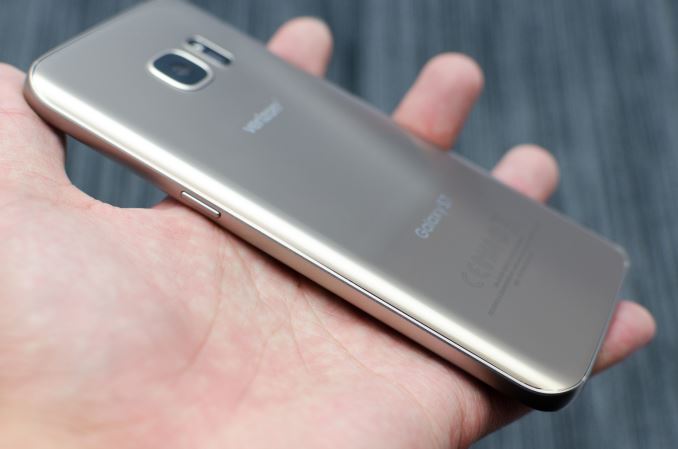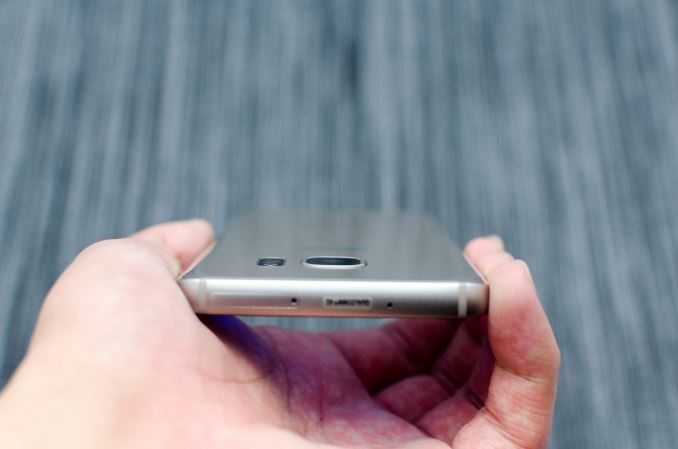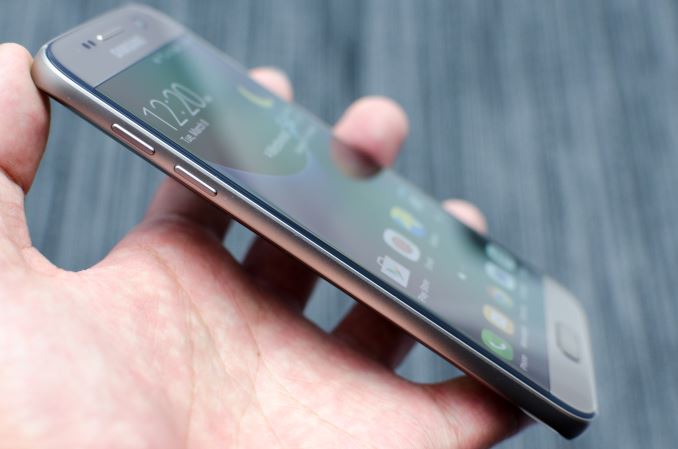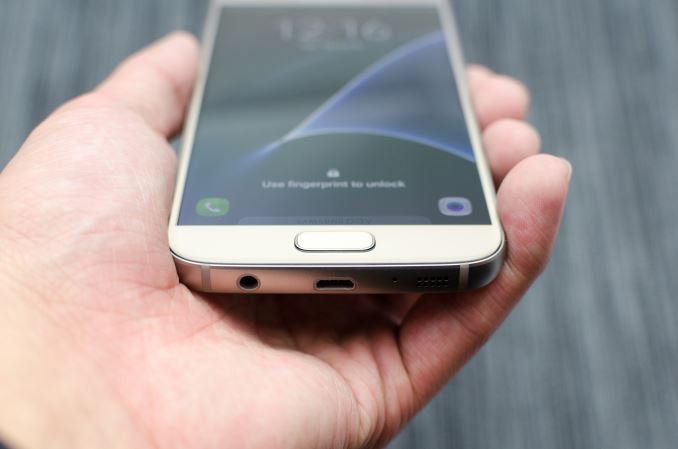The Samsung Galaxy S7 & S7 Edge Review, Part 1
by Joshua Ho on March 8, 2016 9:00 AM EST
For some time now, Samsung has been the dominant player in the Android space, especially at the high end of the market. From the Galaxy S2 onwards, Samsung has been able to ride the wave of the smartphone industry’s growth without much disruption. Samsung has also shown a pretty impressive ability to adapt to changes in the market as seen by their dramatic departure in materials from the Galaxy S5 generation to the Galaxy S6 generation. While the Galaxy S6 was ultimately one of the best phones you could get that year, at least a few design decisions like the loss of removable battery and microSD slot were generally considered to be a step back relative to previous devices.
Throughout their reign of dominance Samsung has always been able to stay on top, however their competition is never too far behind. To that end, it’s probably obvious now that the Galaxy S7 family represents an attempt to improve on the Galaxy S6’s perceived faults, while building upon its perceived strengths. In order to start discussing these changes, we can start by looking at the basic specs and design of the Galaxy S7 and S7 edge.
| Samsung Galaxy S Family | |||||
| Samsung Galaxy S7 | Samsung Galaxy S7 edge | Samsung Galaxy S6 | Samsung Galaxy S6 edge | ||
| SoC | Snapdragon 820 (US, China, Japan) 2x Kryo @ 2.15GHz 2x Kryo @ 1.6GHz Adreno 530 Exynos 8890 (Rest of World) 4x A53 @ 1.58GHz 4x Exynos M1 @ 2.28-2.60GHz Mali T880MP12 @ 650MHz |
Exynos 7420 4x Cortex-A57 @ 2.1GHz 4x Cortex-A53 @ 1.5GHz Mali T760MP8 |
|||
| RAM | 4GB LPDDR4-3600 | 3GB LPDDR4-3100 | |||
| NAND | 32/64GB NAND (UFS) + microSD |
32/64/128GB NAND (UFS) | |||
| Display | 5.1” 1440p SAMOLED |
5.5" 1440p SAMOLED Dual Edge |
5.1” 1440p SAMOLED |
5.1” 1440p SAMOLED Dual Edge |
|
| Network | S820: Qualcomm X12 Integrated 2G / 3G / 4G LTE (Category 12/13) |
2G / 3G / 4G LTE (Category 6) | |||
| Dimensions | 142.4 x 69.6 x 7.9 mm, 152 grams | 150.9 x 72.6 x 7.7 mm, 157 grams | 143.4 x 70.5 x 6.8mm max, 138 grams | 142.1 x 70.1 x 7.0mm max, 132 grams | |
| Camera | Rear Camera w/OIS 12MP (4032 x 3024) Sony IMX260 f/1.7, object tracking AF |
Rear Camera w/OIS 16MP (5132 x 2988) Sony IMX240 / Samsung S5K2P2 f/1.9, object tracking AF |
|||
| Front Facing 5MP, f/1.7 |
Front Facing 5MP , f/1.9 |
||||
| Battery | 3000mAh (11.55 WHr) | 3600mAh (13.86 WHr) | 2550 mAh (9.81 WHr) | 2600 mAh (10.01 WHr) | |
| Launch OS | Android 6 w/TouchWiz | Android 5 w/TouchWiz | |||
| Connectivity | 802.11a/b/g/n/ac 2x2 MU-MIMO + BT 4.2, USB2.0, GPS/GNSS, NFC |
2x2 802.11a/b/g/n/ac + BT 4.1 (BCM4358), USB2.0, GPS/GNSS, NFC |
|||
| Wireless Charging | Yes, Fast Charging | WPC 1.1 (4.6W) & PMA 1.0 (4.2W) |
|||
| Fingerprint Sensor | Touch | Touch | |||
| SIM Size | NanoSIM | NanoSIM | |||
| Launch Price (No Contract) |
$650+ USD | $750+ USD | $650+ USD |
$750+ USD |
|
One of the other major changes in terms of design this time around is electing to go with a significantly larger battery than before. Compared to most other aspects of smartphone technology, battery technology is a more mature field and improves as a slower pace, so the tradeoffs made here result in a thicker device and increased weight relative to the Galaxy S6. However, as we’ll soon see Samsung has made a number of changes in the industrial design which help to mitigate these issues.
Meanwhile, with the Galaxy S7 generation, Samsung has further blurred the line between the Galaxy S lineup and the Galaxy note. The Galaxy S7 edge is a 5.5-inch device - fully into the phablet territory - and only 0.2 inches smaller than the 5.7" Galaxy Note5. This means that the two Galaxy S7 phones are now more significantly differentiated than with the Galaxy S6 generation, where the difference amounted to the dual-edge display and a slightly larger battery. Now the Galaxy S7 edge is larger, ever so slightly heavier, and contains a battery with 20% more capacity than it's base Galaxy S7 brethren.
The final change of note in the Galaxy S7/S7 edge is the camera. With the Galaxy S6 review it was hard to avoid wondering why Samsung didn’t bother to integrate a camera with larger pixel size to improve low light performance, especially when camera was such a significant part of the Galaxy S6 design story with the noticeable camera hump. For the Galaxy S7, Samsung has gone ahead and done just this: the pixel size is now 1.4 micron which should significantly increase the number of situations where the image quality is limited by shot noise rather than image sensor noise. And to top things off the camera hump has now been almost entirely eliminated.
On a quick housekeeping note before we dive in, as we've had less than a week to look at the Galaxy S7, we're dividing up our review into two parts. Today we'll focus on the basics: performance, battery life, design, and the display. Part 2 will go deeper, looking into the Snapdragon 820 SoC in fuller detail, and coupling that with Wi-Fi performance, camera performance, and more.
Design
Now that we’ve gone over the high level changes of the Galaxy S7 and S7 edge, we can start talking about the design of the device. While the Galaxy S6 was an enormous departure from what we were used to seeing from Samsung, the Galaxy S7 is really more an evolution of the Galaxy S6 design. As previously mentioned, it is noticeably thicker and heavier than the Galaxy S6. However, to offset this increase in thickness Samsung has integrated the curved 3D glass of the Galaxy Note5 into the design of the Galaxy S7.
The result of this change is that the Galaxy S7 arguably feels much better in the hand than the Galaxy S6. While I didn’t really have huge issues with the ergonomics of the Galaxy S6, it definitely felt a bit blocky relative to something like the Xiaomi Mi Note Pro and didn’t quite fit in the hand as nicely. The weight increase is noticeable, but not really the end of the world.
The thickness does result in a noticeably reduced camera hump, but on a personal level I never really cared about the camera hump in the Galaxy S6, so I’m not sure I care about the reduction in the camera hump here. I would actually argue that a camera hump is preferable to a camera cover lens that is perfectly coplanar to the back of the phone, as it means that the camera lens isn’t contacting whatever surface I’ve set it down on. While sapphire cover lenses go a very long way to eliminating the potential for scratching a cover lens, there’s also the potential for oil to smear on the camera’s cover lens so I would actually prefer having a camera hump.
The other noticeable change here is the re-introduction of 2.5D curved glass on the edges of the display. I’m not quite sure why Samsung tends to remove and re-introduce this design element seemingly on and off, but it does help with improving the feel of edge swipes at the cost of complicating some things like screen protectors and glass lens durability. Honestly speaking, I’m not sure how much of a difference it makes either way, but it does remove another edge present in the design.
Other than these changes, the design is almost unchanged. The power button remains on the right side of the device and is well-positioned ergonomically. The volume buttons are pretty much in the same place on the left side as well. The 3.5mm jack, micro-USB port, and single speaker are all on the bottom of the device. The only notable deletion in terms of design elements here would be the loss of the IR port on top of the device, which was removed from Galaxy devices starting with the Note5.














202 Comments
View All Comments
Arch_Fiend - Tuesday, March 8, 2016 - link
Very good review the S7 is a beast but so is my iPhone 6s plus. I wish I could afford to have 2 high-end smartphones because I would definitely by the S7 if I could because its finally the android phone i've been waiting for.Cant wait for review part 2.
misteroh - Tuesday, March 8, 2016 - link
I'm very glad you updated your battery testing methodology. I have the LG G4 and my personal experience with its battery life is MUCH closer to your 2016 test results than the 2013. The older test would have you believe it has much better than average battery life, but I personally find myself charging it much more often than I want to.stlc8tr - Tuesday, March 8, 2016 - link
I'm curious about the microSD card slot performance. If you put a fast (<80MB) microSD card in the GS7, are you going to see the difference over a slower card?Also, how fast is the USB MTP performance? Did Samsung re-introduce a USB3 connection?
tipoo - Tuesday, March 8, 2016 - link
It would depend on what you put on the card. Videos and music would probably see no difference. Apps, and if the camera can write directly to the card, maybe.H4CTOR96 - Friday, March 18, 2016 - link
I put a Sandisk 64gb Extreme on mine and A1 SD Bench returns 60Mb/s read and 40Mb/s write. For comparison the Internal storage works at 300 read and 150 write....Then I put in a crappy $7 32gb sd card and it scored 1032 write and 1.02 read, so yeah there was something wrong with that one XD
name99 - Tuesday, March 8, 2016 - link
"Of course, other than the workload the device setup has been held constant across these tests by equalizing ... disabling all background sync to the best of my ability."Is this really a good idea? Id argue that part of what you are buying when you buy these devices is proper setup. (Certainly, for example, that's part of what Apple would say they are selling.) As such, I'd consider that the right way to benchmark them is in some sort of "as close to out-the-box" state as possible. Sign up for everything the device asks you to sign up for out the box. (For Apple that will be to enter an AppleID, for Android I assume it will always ask for a Google ID and then some random collection of additional logins that people have paid the phone vendor to request.)
Then see how the phone behaves under those conditions. The Apple pone will presumably occasionally sync with iCloud. The Android phone will sync with various Google Services. And if the vendor asked you to sign up for "MyWannabe Social Network" and "MyWannabe Social Network" delivers ads to the device every three minutes, constantly sucking up power and CPU, THAT IS THE EXPERIENCE THE PHONE IS SELLING YOU.
Vendors that sell crap like that should accept the consequences in reviews. It's not AnandTech's job to spend an hour scrubbing some phone of useless crap. It is, in fact, AnandTech's job to run the phone with precisely all that crap enabled --- and then let us know the results.
Andrei Frumusanu - Tuesday, March 8, 2016 - link
By background syncing Josh is mostly referring to disabling application auto-updates and other such services which can have an impact on battery life tests. The usual small sync services and GMS have little to no noticeable impact on these tests.I disagree on your viewpoint about out-of-box software settings simply because the phones have different software and services depending on your region. North American units from carriers will have different settings and services than the international units. We don't always get samples from the same carrier even. AnandTech has been first and foremost a hardware site so I think it's correct to try to minimize the effect of such services to get a better representation of what the device itself is capable of, not what the carriers choose to add in or not.
Again, this is all overblown as in practice we see little to no effect on our tests and again we're mostly referring to auto-updates and the like which can eat up singificant amount of CPU cycles.
name99 - Tuesday, March 8, 2016 - link
" Always-On Display is nice to have, but for some reason it only polls the ambient light sensor, so the display won’t actually turn off in your pocket. As a result I turned it off as it’s clearly going to be contributing to idle battery drain in situations where it shouldn’t."Like I said...
I think it is not helpful to improving phones generally when reviewers accept stupidity like this.
If Samsung ship with a feature that's not ready for primetime, the review numbers (in this case battery life) should show it. I don't understand why so many phone users are willing to make excuses for manufacturers and just accept babysitting their machines, manually switching on and off GPS, Bluetooth, WiFi, NFC, etc as the situation demands.
My devices should damn well operate themselves, not rely on me to do it for them.
adityarjun - Tuesday, March 8, 2016 - link
If you do a quick google search, you'll see that a lot of users are still facing keyboard lag. Check reddit and xda.I would like to hear your thoughts on the same and whether you are also facing such issues.
jhh - Tuesday, March 8, 2016 - link
Still disappointed that Samsung didn't at least allow enabling using the SD card as extended internal memory. Yes, some people want to swap the cards in and out, but others have found they have run out of internal memory, and have no choice but to buy a new phone without this feature.